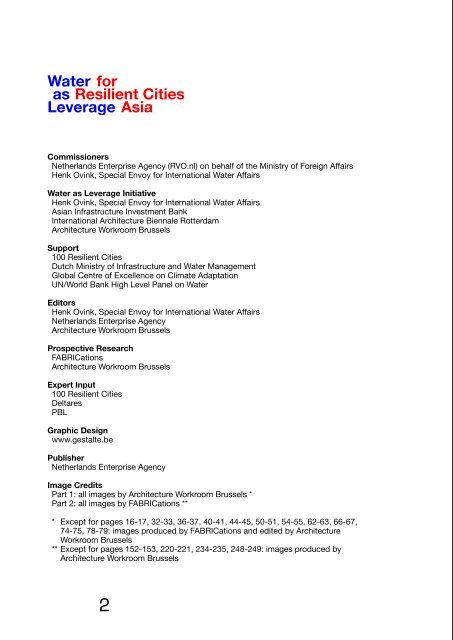Water as Leverage- Setting the scene for a call for action
- No tags were found...
Create successful ePaper yourself
Turn your PDF publications into a flip-book with our unique Google optimized e-Paper software.
<strong>Setting</strong> <strong>the</strong> Scene <strong>for</strong> a Call <strong>for</strong> Action<br />
Commissioners<br />
Ne<strong>the</strong>rlands Enterprise Agency (RVO.nl) on behalf of <strong>the</strong> Ministry of Foreign Affairs<br />
Henk Ovink, Special Envoy <strong>for</strong> International <strong>Water</strong> Affairs<br />
<strong>Water</strong> <strong>as</strong> <strong>Leverage</strong> Initiative<br />
Henk Ovink, Special Envoy <strong>for</strong> International <strong>Water</strong> Affairs<br />
Asian Infr<strong>as</strong>tructure Investment Bank<br />
International Architecture Biennale Rotterdam<br />
Architecture Workroom Brussels<br />
Support<br />
100 Resilient Cities<br />
Dutch Ministry of Infr<strong>as</strong>tructure and <strong>Water</strong> Management<br />
Global Centre of Excellence on Climate Adaptation<br />
UN/World Bank High Level Panel on <strong>Water</strong><br />
Editors<br />
Henk Ovink, Special Envoy <strong>for</strong> International <strong>Water</strong> Affairs<br />
Ne<strong>the</strong>rlands Enterprise Agency<br />
Architecture Workroom Brussels<br />
Prospective Research<br />
FABRICations<br />
Architecture Workroom Brussels<br />
Expert Input<br />
100 Resilient Cities<br />
Deltares<br />
PBL<br />
Graphic Design<br />
www.gestalte.be<br />
Publisher<br />
Ne<strong>the</strong>rlands Enterprise Agency<br />
Image Credits<br />
Part 1: all images by Architecture Workroom Brussels *<br />
Part 2: all images by FABRICations **<br />
* Except <strong>for</strong> pages 16-17, 32-33, 36-37, 40-41, 44-45, 50-51, 54-55, 62-63, 66-67,<br />
74-75, 78-79: images produced by FABRICations and edited by Architecture<br />
Workroom Brussels<br />
** Except <strong>for</strong> pages 152-153, 220-221, 234-235, 248-249: images produced by<br />
Architecture Workroom Brussels<br />
The Challenge<br />
<strong>Water</strong> represents humanity’s most<br />
challenging and complex risk. Floods and<br />
droughts, pollution and conflicts related to<br />
water combine in conceivably dis<strong>as</strong>trous<br />
ways with rapid urbanization, a growing<br />
demand <strong>for</strong> food and energy, migration, and<br />
climate change. This makes water one of <strong>the</strong><br />
greatest risks to economic progress, poverty<br />
eradication and sustainable development.<br />
Floods and droughts already impose huge<br />
social and economic costs around <strong>the</strong><br />
world, and climate variability will make water<br />
extremes worse. If <strong>the</strong> world continues on its<br />
current path, projections suggest that we may<br />
face a 40% shortfall in water availability by<br />
2030. This means that <strong>the</strong> global water crisis<br />
can be considered <strong>the</strong> biggest threat facing <strong>the</strong><br />
planet over <strong>the</strong> next decade.<br />
That is why, in 2016, United Nations<br />
Secretary General Ban Ki-moon and World<br />
Bank President Jim Yong Kim convened a High<br />
Level Panel on <strong>Water</strong> (HLPW) with 11 sitting<br />
Heads of State and Government, including<br />
<strong>the</strong> Dutch Prime Minister Rutte, to help put<br />
water higher on <strong>the</strong> global agenda and work on<br />
interventions and investments. On 14 March<br />
2<br />
Introduction<br />
3


















